How pharma marketers can leverage LinkedIn for HCP engagement
Oct 6
Our "Social Media Strategy & Planning" course offers comprehensive guides on 10 essential channels that pharma marketers can use to engage their audiences. In this blog post, we give a sneak peek at how pharma marketers can leverage LinkedIn to connect with healthcare professionals (HCPs), providing examples of how to raise disease awareness, share educational materials, support health policy initiatives, drive event sign-ups, and generate leads.
LinkedIn is the world’s largest professional network, with over 1 billion members globally, making it a crucial platform for pharma marketers looking to reach healthcare professionals, including doctors, nurses, lab professionals, scientists and policy makers. According to LinkedIn Industry Pulse Healthcare 2025, over 154 million people engage with health-related content, with a 21% year-on-year increase in healthcare conversations.
In this article, we focus on activities that pharma marketers can activate in markets where direct branded content cannot be mentioned, such as the UK, EU, and Australia. In these regions, the emphasis shifts from branded product promotion to unbranded educational and disease awareness campaigns. While compliance requirements vary across markets, the strategies outlined here are designed to work in environments where branded content is restricted.
In this article, we focus on activities that pharma marketers can activate in markets where direct branded content cannot be mentioned, such as the UK, EU, and Australia. In these regions, the emphasis shifts from branded product promotion to unbranded educational and disease awareness campaigns. While compliance requirements vary across markets, the strategies outlined here are designed to work in environments where branded content is restricted.
Key strengths of LinkedIn for pharma marketers
LinkedIn offers several key advantages that make it an ideal platform for pharma marketers looking to reach HCPs:
-
Paid Media Targeting: LinkedIn’s advanced targeting capabilities allow pharma marketers to reach healthcare professionals by job title, seniority, industry, and employer, ensuring your content is shown to the right people.
-
Professional Engagement: LinkedIn is designed for professional engagement. It’s the perfect space for sharing industry updates, educational content, and research findings that resonate with healthcare professionals.
-
Content Variety: From long-form articles to videos, documents, and live events, LinkedIn supports a range of content formats. Pharma marketers can take advantage of this to provide in-depth, valuable information (like medical education) to their audiences.
-
Trusted platform: LinkedIn offers a safer, more professional space for pharma marketing at a time when X (Twitter) is declining in trust, usage, and brand safety.
Top use cases for pharma on LinkedIn
LinkedIn offers numerous opportunities for pharma marketers to engage with healthcare professionals and other key stakeholders. We've included a range of examples here, but you'll find many more, as well as more in-depth guidance, in our Social Media Strategy & Planning course.
1. Awareness and education
LinkedIn is an effective channel for unbranded disease awareness and education efforts targeted to professional audiences. As the topics that interest professional audiences are often going to require more in-depth content (like that found on a website), your LinkedIn activities may focus more on raising awareness, teasing and piquing the interest of your audience and driving them to a web property for more information. To link up with branded or treatment-focused content, you could also drive to web properties where they must log in or verify HCP status before accessing the material.
Example: This Roche post shows how LinkedIn can share valuable insights with clinicians, in this case on treating a rare cancer. By highlighting a challenge that’s top of mind for oncologists, it grabs attention, then drives to a website for deeper exploration.
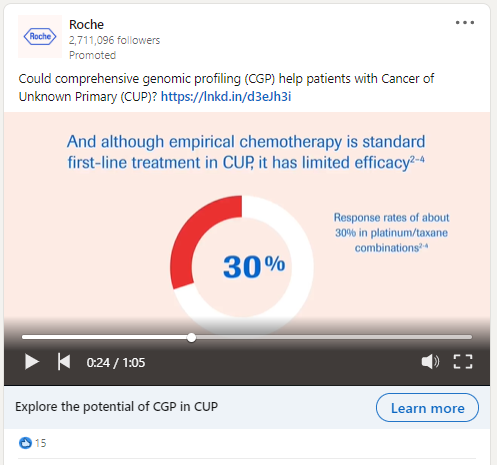
Example: This example illustrates how LinkedIn can be utilised to promote medical education initiatives using eye-catching creative. It appeals to time-poor HCPs by offering educational content they can access quickly.
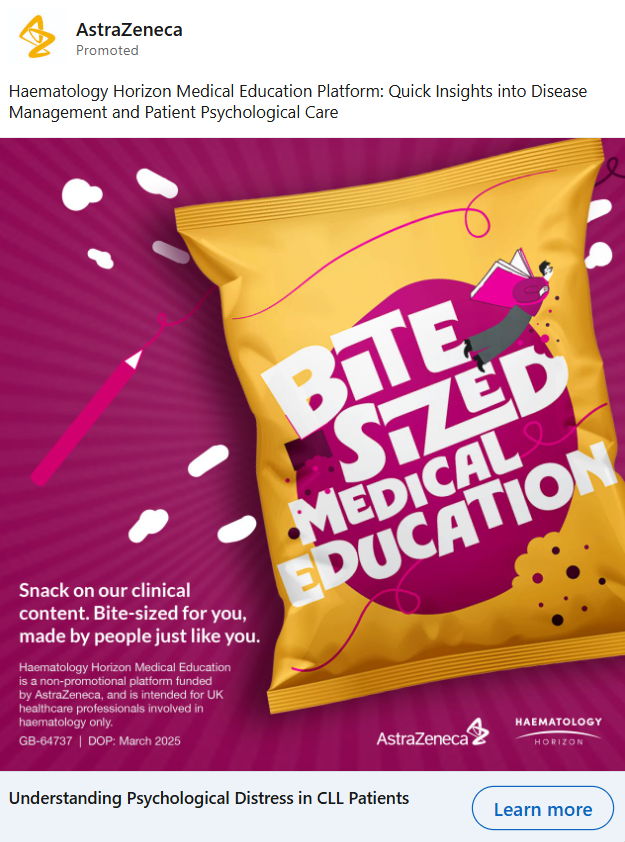
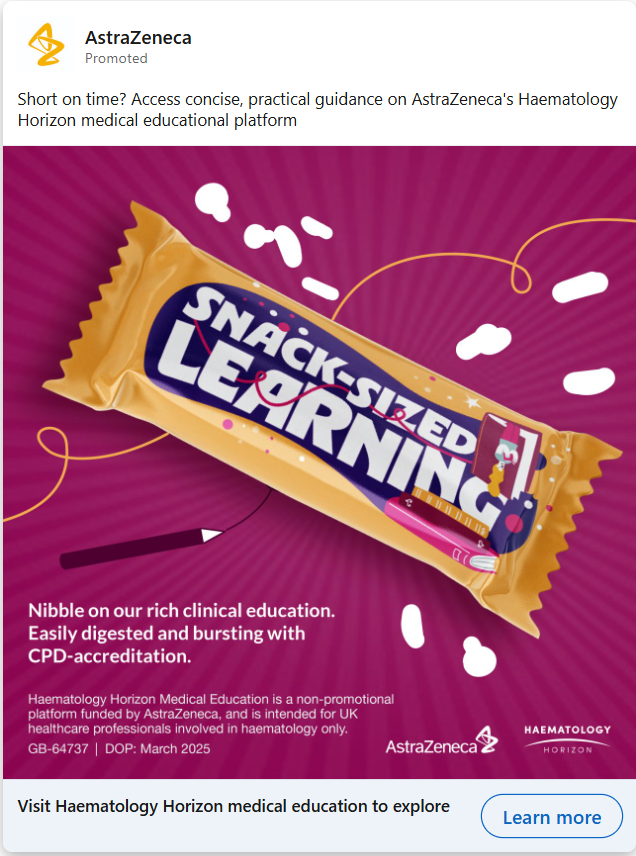
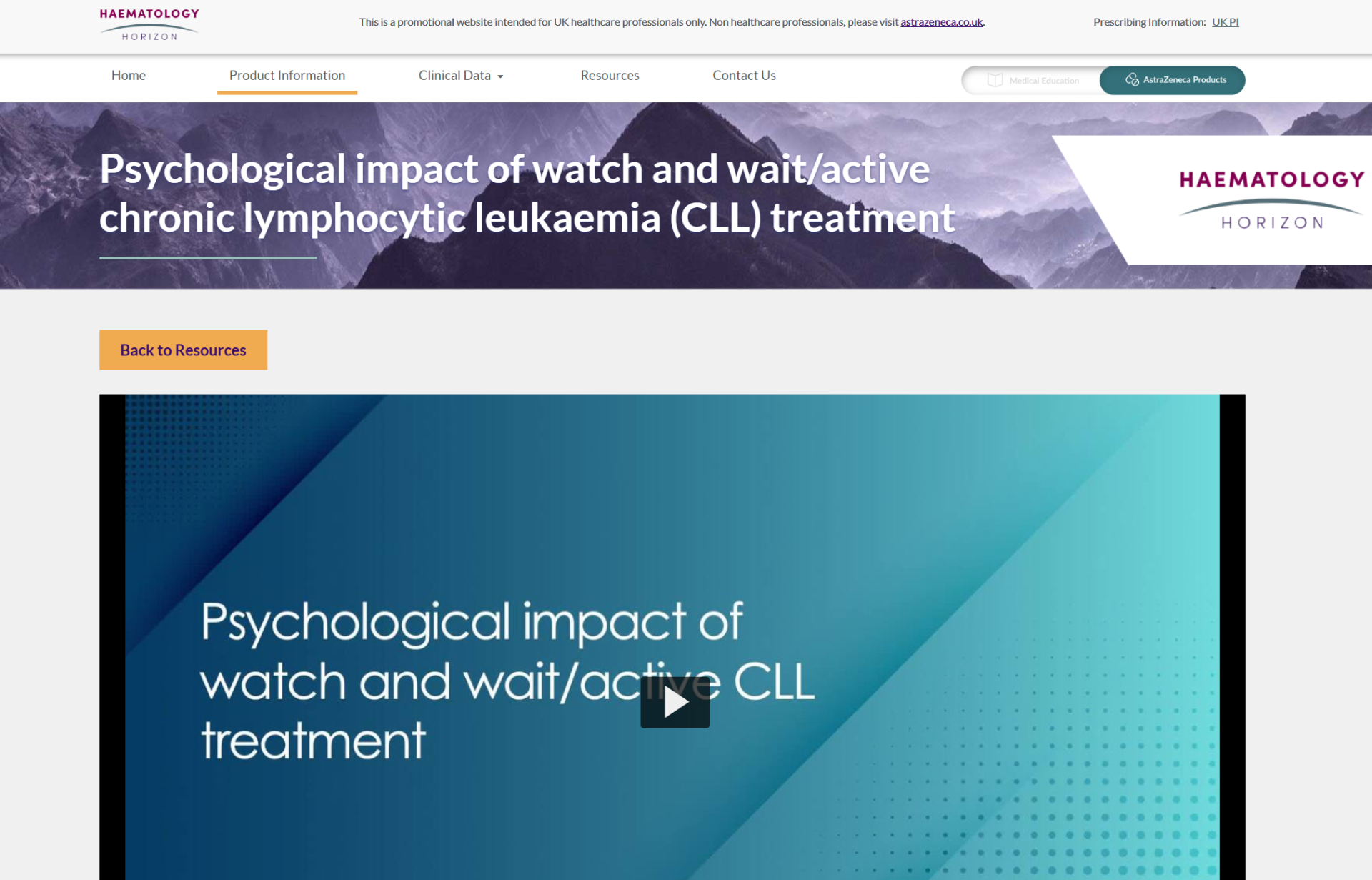
AstraZeneca have used a variety of formats to engage HCPs. Below is an example of a sponsored InMail, which appears directly in an HCP’s LinkedIn inbox, with the FIRSTNAME field dynamically personalised.
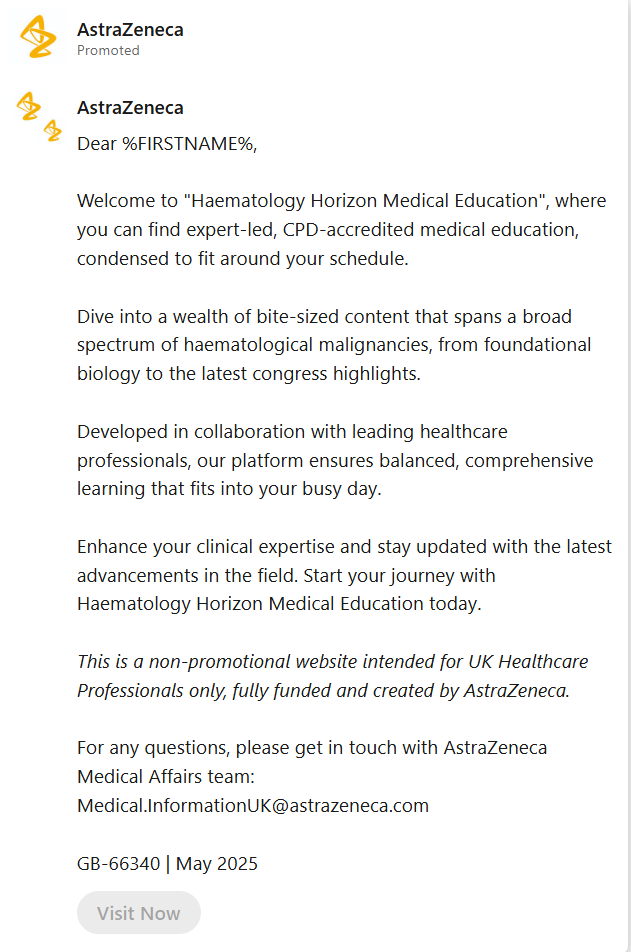
Top tips for pharma marketers using LinkedIn for disease awareness and education
-
When teasing content before directing someone to a website, give enough context to spark interest and build intrigue.
-
Match expectations between your LinkedIn post and your web destination. Ensure that your website delivers on the promise set up in the content of your social media posts.
-
Keep in mind what makes good social content for HCPs: focus on what they want from pharma, such as educational videos, real-world evidence, patient case studies, CME opportunities, diagnostic support, and insights from medical congresses.
-
Consider how you can make your content stand out in the newsfeed. Whilst educational content should speak to a rational, logical argument, also keep in mind that purely logical content doesn't always capture and keep attention. Think about if there is a role for more emotive content (like patient perspectives) or key voices that can help HCPs connect with the message.
2. Health Policy Initiatives
LinkedIn can be a great channel for engaging hard-to-reach audiences, such as health policymakers. It offers the ability to shake up the usual methods of white papers and roundtables, and show up where policy makers are spending time online with impactful digital campaigns that can help to highlight where there is a need for policy reform. Social media and digital activations can be effective for this audience as they have an element of 'social proofing', whereby policy makers can see the level of engagement and support for the topic from others online.
AstraZeneca, for example, launched a campaign around COPD (Chronic Obstructive Pulmonary Disease), using LinkedIn ads to raise awareness of the condition and its impact on patients. By driving traffic to a dedicated website, they called for support for policy reform, helping to build momentum for a needed change in health policy.
AstraZeneca, for example, launched a campaign around COPD (Chronic Obstructive Pulmonary Disease), using LinkedIn ads to raise awareness of the condition and its impact on patients. By driving traffic to a dedicated website, they called for support for policy reform, helping to build momentum for a needed change in health policy.
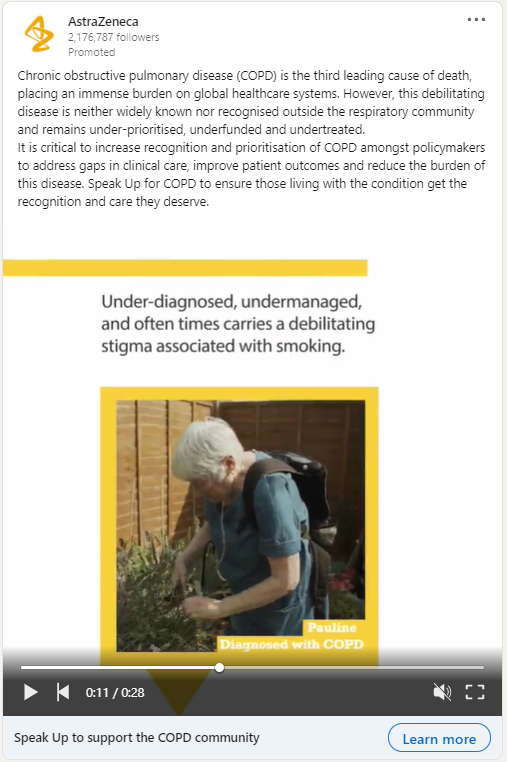
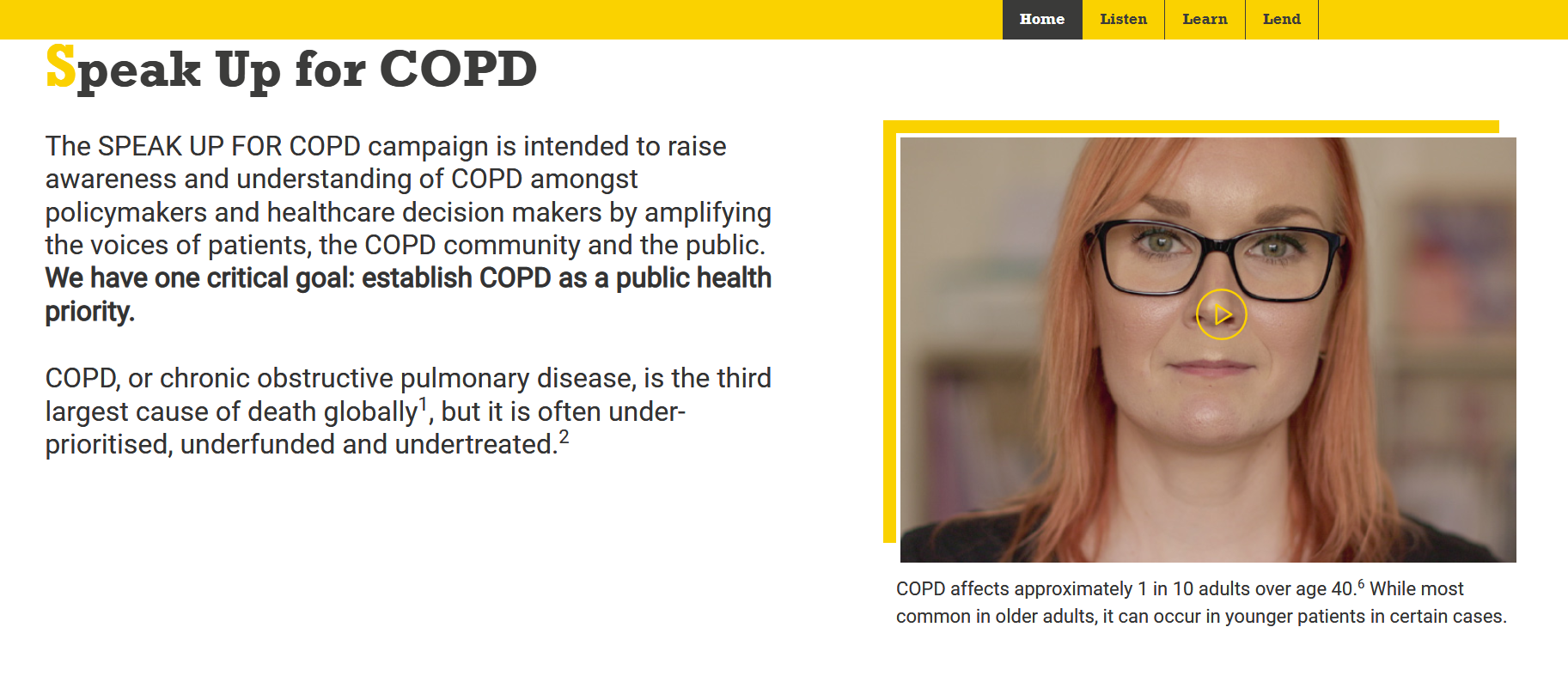
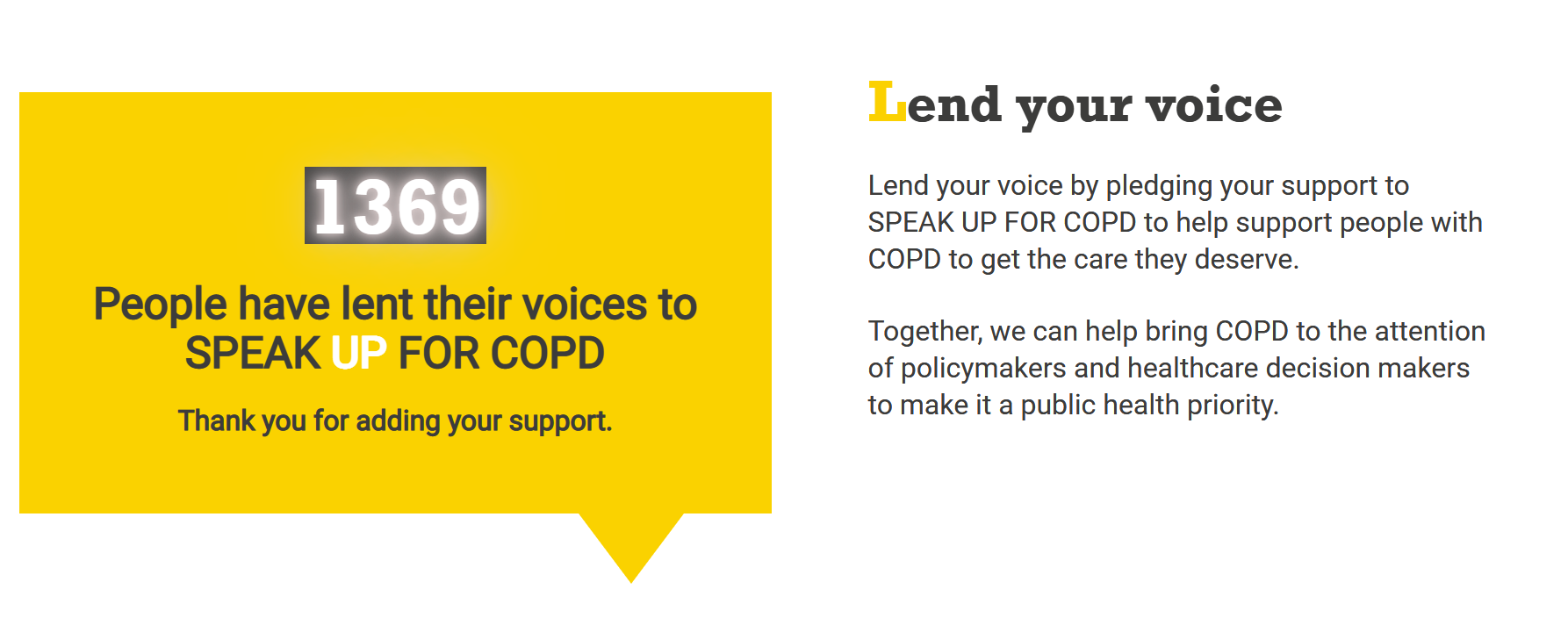
In the ad transparency centre, we can see that this is a global social media campaign with recent promoted content on LinkedIn targeting North America, Asia and South America, Europe, Africa, Oceania, Latin America and excludes Saudi Arabia, South Africa and Pakistan, India, Egypt, United Arab Emirates, Brazil. This focused on continued push for a focus on COPD in health policy decisions, driving through to the same website to make a pledge to support.
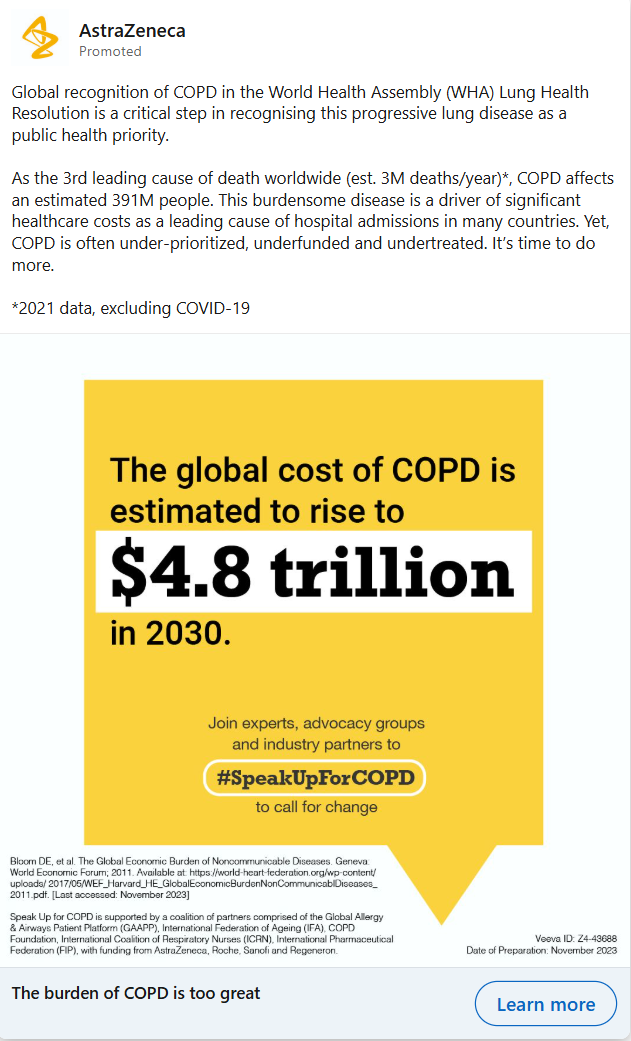
Below is an example of content targeted to policy makers in a range of countries, focused on getting kidney health top of the agenda. AstraZeneca co-created this with a patient advocacy group, and used LinkedIn to drive traffic to their website.
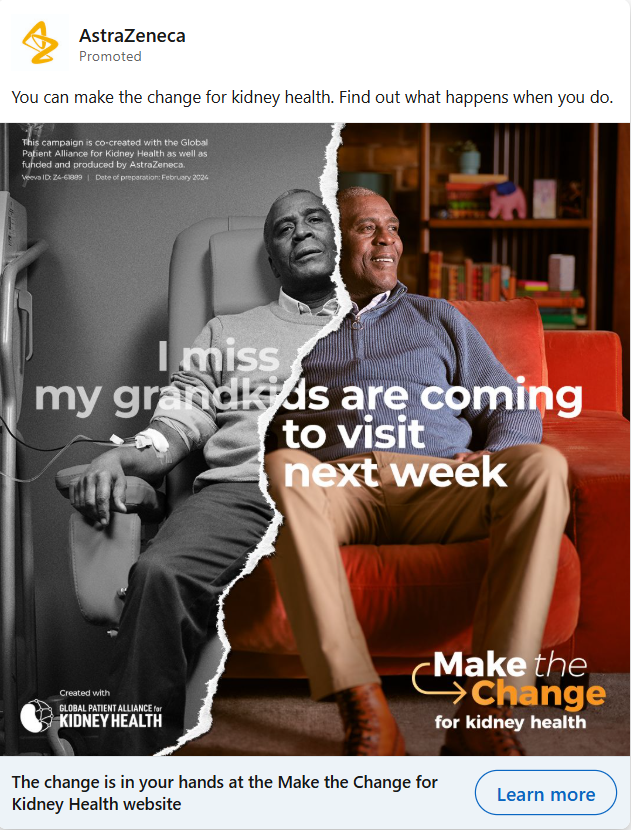
Employees shared the initiative on LinkedIn, which AstraZeneca amplified with paid media to increase their post reach to the desired target audience.
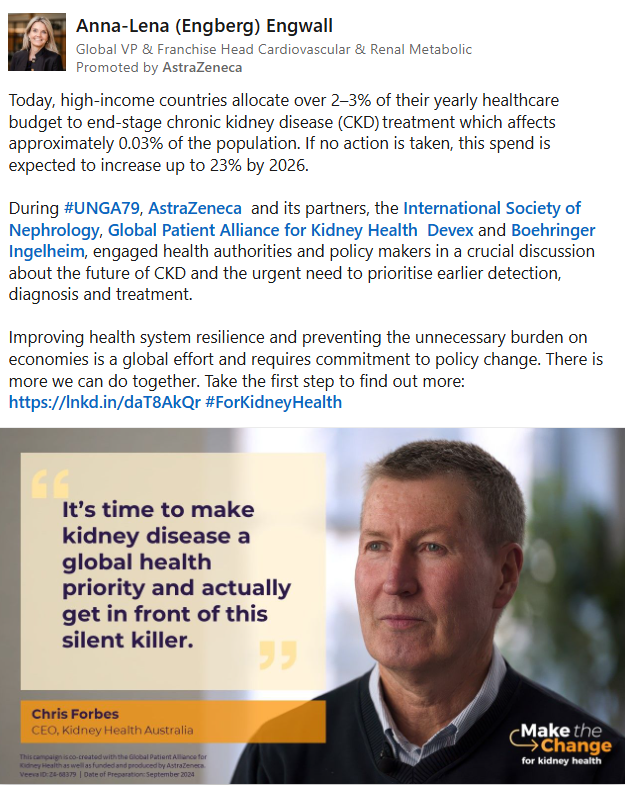
Top tips for pharma marketers using LinkedIn for health policy campaigns
-
Health policy audiences are generally quite small. This means that it's important that you plan to frequently update your content to avoid asset / audience fatigue.
-
Consider how you can include an engagement mechanism, like a virtual pledge, that helps to show the community and social desire for change.
3. Event promotion
LinkedIn can be an effective way to drive awareness and attendance for offline events, especially if you have a small or limited salesforce. It can also help reach audiences beyond your reps’ territories.
Example: AstraZeneca used social media to drive attendance at a CLL event featuring KOL speakers. The speakers were highlighted in LinkedIn content, including a sponsored InMail sent from an HCP profile. Because HCPs were vetted before accessing the website, branded products could be discussed. This demonstrates how unbranded social media can link to branded activities and support lead generation.
Example: AstraZeneca used social media to drive attendance at a CLL event featuring KOL speakers. The speakers were highlighted in LinkedIn content, including a sponsored InMail sent from an HCP profile. Because HCPs were vetted before accessing the website, branded products could be discussed. This demonstrates how unbranded social media can link to branded activities and support lead generation.
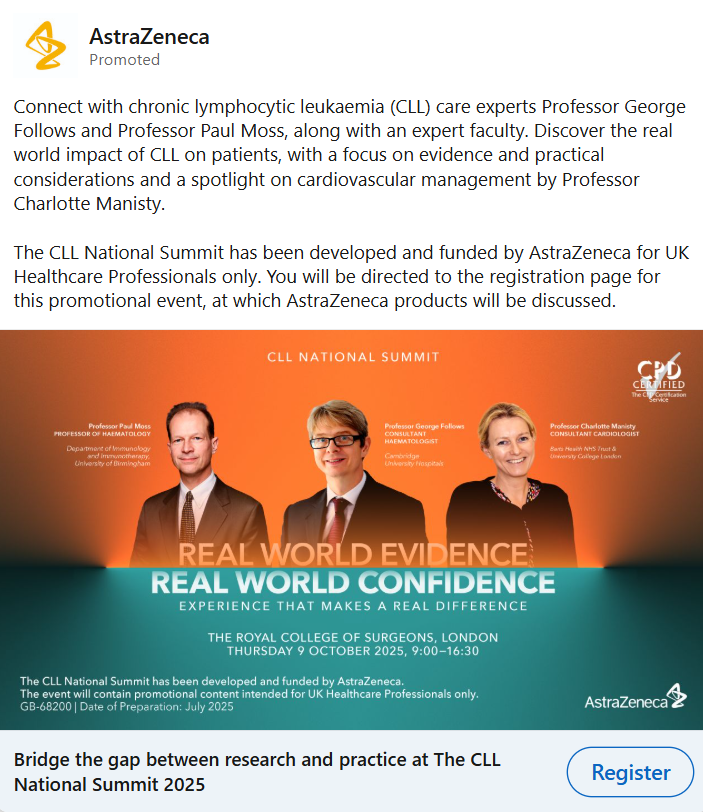
After clicking on a link HCPs are taken through to the event landing page where they can see more about the agenda, speakers. timing and register for the event. This is shown in the video below.
Write your awesome label here.
AstraZeneca also used sponsored InMail, leveraging paid media to send messages directly to HCP LinkedIn inboxes from the profile of an event speaker.
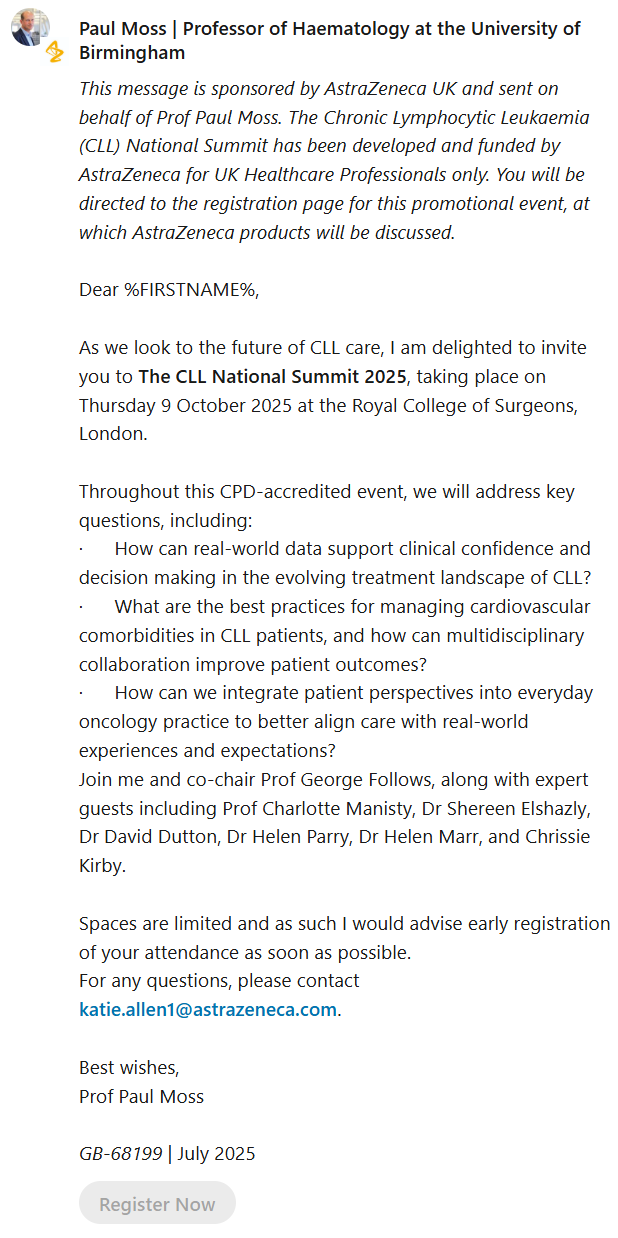
4. Webinars and panel discussions
LinkedIn is also an excellent platform for engaging professional audiences with webinars, panel discussions, and live events. These interactive sessions offer a more personalised approach to social media and can still be a great tool for connecting HCPs across geographical boundaries. These events can be hosted on LinkedIn or another platform, with LinkedIn used to drive traffic and encourage registrations.
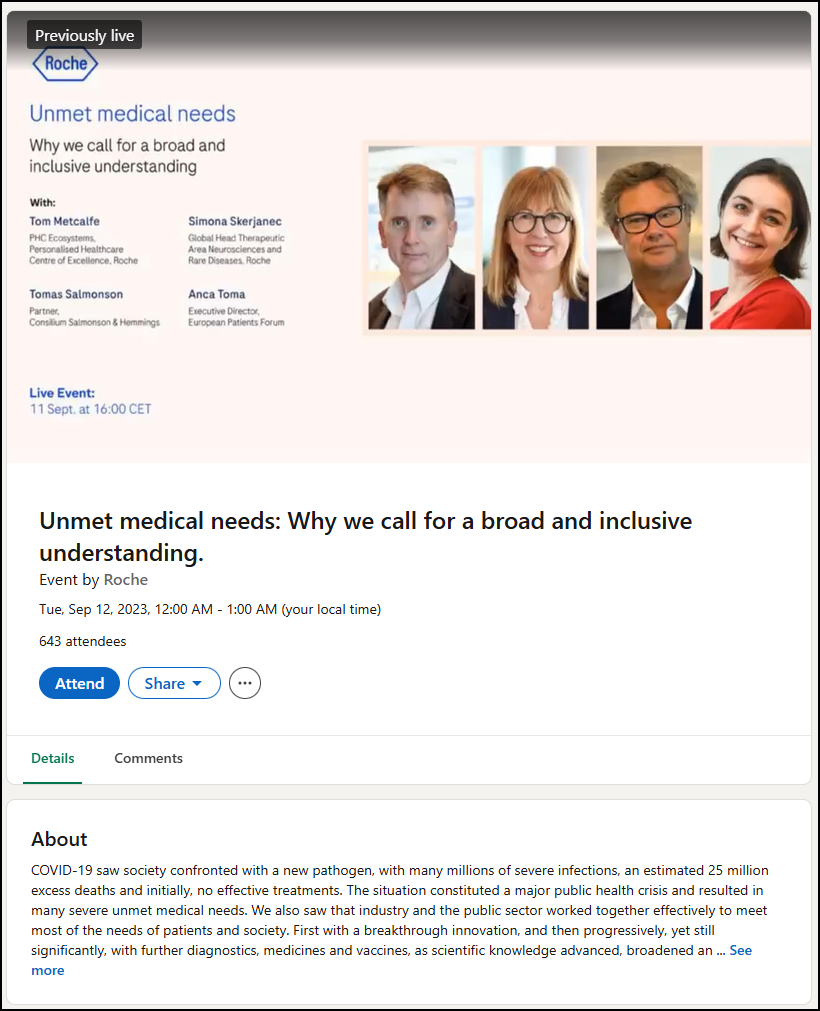
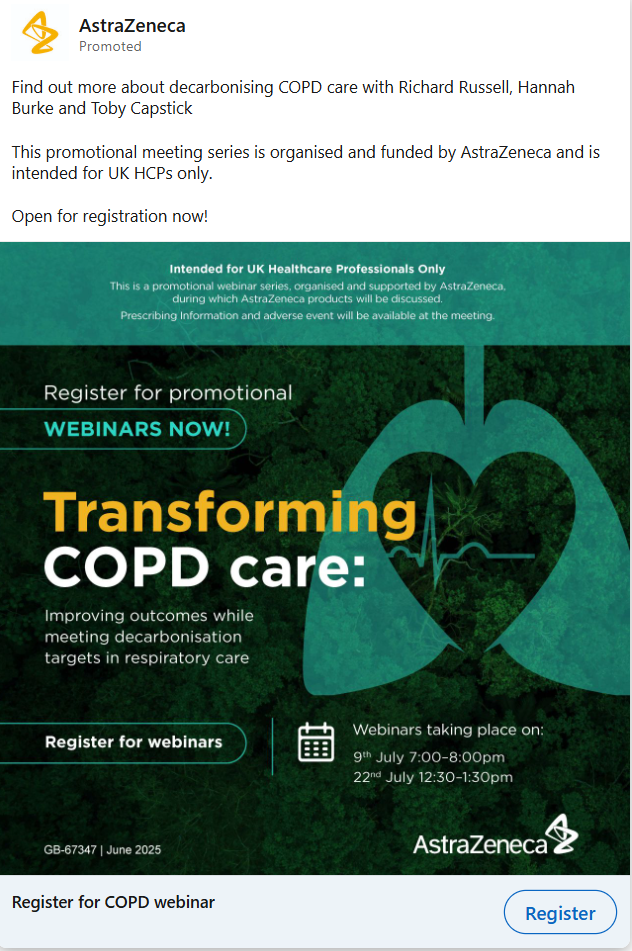
5. Lead generation
LinkedIn’s lead generation tools let pharma companies capture contact details from interested healthcare professionals in exchange for valuable content such as white papers, case studies, or a direct connection with your team. For example, Pfizer used LinkedIn to promote video content that encouraged doctors to complete lead gen forms for a follow-up discussion with one of their sales representatives.
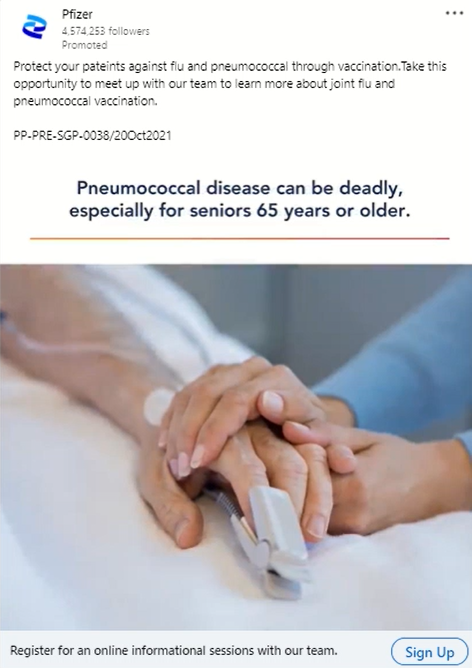
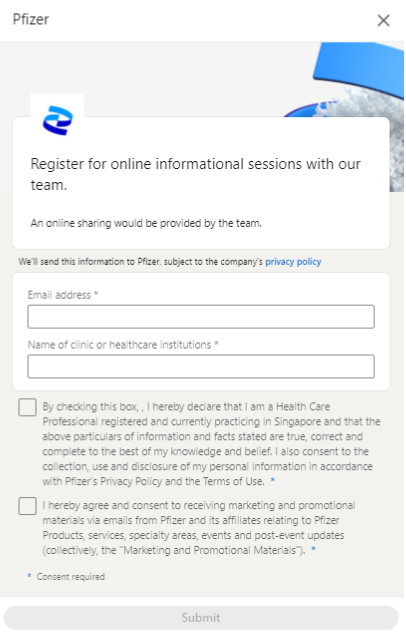
Top tips for pharma marketers using LinkedIn for lead generation
-
Reduce the number of clicks before someone converts by collecting leads using a lead generation form (this is a LinkedIn format), rather than driving off to a website.
-
Ensure you have mapped out the email journey once someone provides their information, and plan what actions will follow beyond the first touchpoint.
-
Ensure any new HCP information collected is formatted consistently with the tagging and setup of your existing CRM. This makes it easier to take action on those contacts later.
Gain a competitive edge in pharma marketing
Master social media in healthcare with our in-depth Social Media Strategy and Planning course, packed with practical theory, downloadable resources, and real-world pharma case studies.
Select a course to start your learning journey

Today, social, CX and digital are the most needed skills in pharma but the hardest to get access to. We’re here to bridge that gap. We’re committed to delivering practical and relevant courses in digital and social media, specifically aimed at the pharmaceutical industry. Our mission is ‘to accelerate pharma medical marketing into the now’
Featured links
Copyright © 2025

